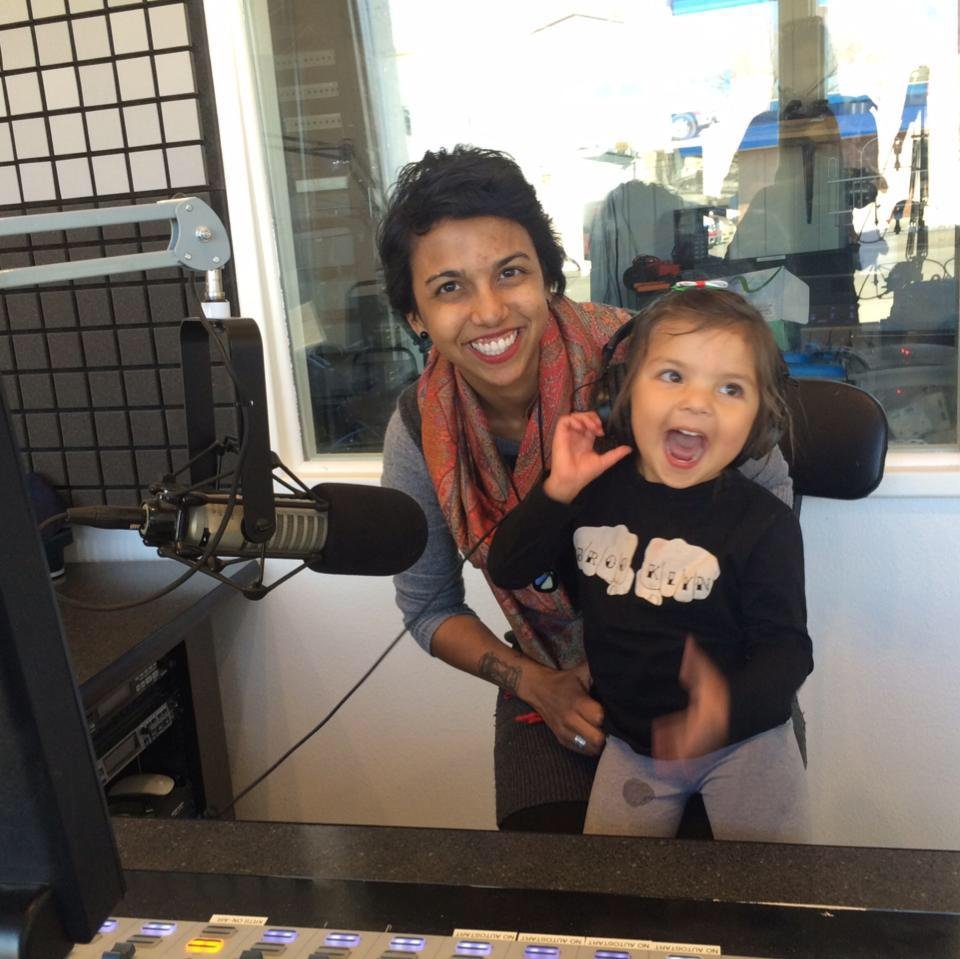In 2014, at the tail end of Maria Garcia’s pregnancy, she was diagnosed with preeclampsia, a potentially dangerous complication characterized by high blood pressure. She was put on bed rest for an entire month. Unable to work, Garcia, an anchor and investigative reporter at El Paso’s ABC-7, says she had to prematurely dip into her three-month maternity leave. For the first six weeks of that leave, she received her full salary, but after that, she only got half.
And so Garcia found herself in a position familiar to many working mothers; soon after childbirth, she was back in the office, juggling her financial and familial obligations.
ICYMI: One question that turns courageous journalists into cowards
After two months of staying home with her new son, Jael, Garcia returned to a busy daily schedule of anchoring and reporting while toggling between pumping breast milk and rushing home to nurse. Without her mom, she and her fiancé, Eddie Cepeda, would not have been able to afford childcare.
The media industry is notoriously hard on moms, and the news business isn’t getting much better. With the rights of women in the workplace front and center at this moment—and what a rare moment it is—it’s an ideal time to examine other policies (or lack thereof) that leave women at a disadvantage in their careers. The Family Medical Leave Act, signed into law 25 years ago today, requires employers provide 12 weeks of job-protected unpaid leave to employees who’ve worked at a company for a year or more, but there’s no requirement for paid leave, as offered in countries like Sweden and Canada. A Poynter survey from this past summer found that two-thirds of media companies offer some paid parental leave, but policies vary.
When it comes to the job satisfaction of female employees, the media ranks lower than the banking, public relations, and technology industries, according to Fairygodboss, a site where women write anonymous reviews of their employers and rank family-friendly policies and culture. VICE Media, for example, earned only 1.3 stars out of 5, with one reviewer writing, “Most executives are men or if you find a woman, it’s someone who has been at the company for 10+ years. They are sexist in meetings, content and overall.” A reviewer for Condé Nast, which has a 2.8 ranking, notes that “the family leave policy is the minimum and unpaid (at least it was last I checked).”
When it comes to the job satisfaction of female employees, the media ranks lower than the banking, public relations, and technology industries.
Gannett has a rating of 3.3, but reviews are mixed when it comes to the publisher’s family-friendliness. This isn’t unusual for big companies; certain managers and departments might be more supportive to working parents than others. One Gannett reviewer from the company’s finance department wrote, “You can expect to be paid less than male peers…work/life balance just doesn’t exist – you have to protect your time fiercely. If you’re lucky you’ll get a great manager, it’s about 50/50.” Gannett, Condé Nast, and Vice didn’t respond to repeated requests for comment, and Refinery29 declined to address the Fairygodboss review.
ICYMI: 11 images that show how the Trump administration is failing at photography
Sadly, none of this is especially surprising. In media, salaried employees, especially those in entry-level positions, are often expected to work 12-hour days and some weekends, pull all-nighters, and be ready to respond swiftly to breaking news. Challenges for working parents exist in any industry, but the news cycle comes with unique demands. How are parents in the field supposed to keep up with these expectations without sacrificing too much time with their families?
Often, those sacrifices fall to women. Even today, women typically bear the brunt of domestic work, which is why, according to a study by the University of Kansas, they are more susceptible to burnout. The study also found that female journalists consider changing careers at higher rates than their male counterparts, due to feeling a lack of support from their organizations. Possibly even more troubling: Recent research by the American Sociological Association found that managers are more likely to grant requests from dads for family-related flexibility than moms, and are viewed more favorably than women by employers after asking for childcare.
The challenge of being both journalist and mother is not foreign to me. In 2013, I broke into the media industry after interning at Marfa Public Radio and reporting on city council meetings for a news station in Alpine, Texas. I was also a 22-year-old single parent to a growing toddler. Thankfully, before moving to New York City, I could rely on my parents to watch my daughter while I reported at council meetings or edited stories. But when I moved in 2015, that luxury vanished.
When it comes to young, single moms, there’s little understanding about our lifestyles and needs. In fact, a recent survey about work-life balance conducted by Poynter found that those in media “are overwhelmingly worried about their career prospects after becoming parents and say they have few role models in management who demonstrate what it means to have a viable balance between work and caregiving responsibilities.”

The author poses with her daughter, Amora, at her old internship at Marfa Public Radio. (Courtesy of Natalie Pattillo)
Finding childcare when news breaks can be particularly problematic when your spouse is in the same field. When Steve Jobs died, for instance, tech journalist Lisa Schmeiser and her husband had to cover it for their respective publications. “Only one of us was calling the nanny to make sure she could stay late, and then calling the backup babysitter to make sure that when the nanny left, somebody else was taking care of our then very small daughter,” says Schmeiser, a content director for ITPro Today, an online publication for information technology, and editor in chief of Windows Secrets, the sister site for ITPro Today. “It was me making those calls.”
Some states are taking action to make it easier for working parents. In January, New York State began phasing in a program that will mandate up to 12 weeks of paid family leave for all expectant parents (by birth or adoption), regardless of their company’s size.
If moms leave the field because they aren’t supported and burn out, that’s bad business for media companies. Tackling Child Care, a seminal report conducted by International Finance Corporation, makes the financial case for why employers should offer childcare. Based on the report’s findings, providing employees with childcare programs can reduce employee turnover by 37 to 60 percent, which saves the company money. “If [media companies] have sunken resources into training these people, they are no less valuable just because they’ve had kids,” says Scheismer.
When media companies don’t prioritize working parents, they aren’t only throwing away money, they’re compromising storytelling and newsroom diversity. “In journalism, we need to make sure we’re representing what the country looks like and we need the voices of parents to make sure we are doing it correctly,” says Nadia Reiman, a New York City-based senior producer at LatinoUSA and mother of a 2-year-old. “It’s more about being accurate even.”
Managers are more likely to grant requests from dads for family-related flexibility than moms, and are viewed more favorably than women by employers after asking for childcare.
The Times offers its employees paid parental leave, subsidized back-up childcare, and the flexibility to work remotely. As a result of an internal grassroots effort in 2015, full-time employees, including adoptive parents, are entitled to 10 weeks of paid parental leave; birth mothers can also receive an additional six to eight weeks of paid disability leave. On top of that, adoptive parents are offered $5,000 to help with the cost of adoption.
The New York Times is “constantly looking to be best-of-class” when it comes to providing benefits to moms and dads, says Ellen Shultz, the executive vice president of talent and inclusion at the company. Shultz, who is also a mom to a kindergartner, says if employees are given tools—like parental wellness policies—to deal with their lives outside of the office, they can effectively be their most creative, resilient, and productive selves while at work.
The paid-leave policy is also a boon for same-sex couples who opt for children, such as Yosef Seifu, a director of human resources information systems strategy at NYT, and his husband. As an expectant parent in a same-sex marriage, Seifu feels at ease that his company thinks about parental leave and benefits beyond just birth mothers. “Being a nontraditional parent in this environment is a bit unnerving, but without the paid leave from the the Times, I’m not sure how we’d do it, because my husband’s job in academia doesn’t offer much.”
RELATED: USA Today loses 5.8 million Facebook followers, and no one knows why
BuzzFeed is exploring how to make parental leave an easier experience for employees. A primary caregiver (adoptive parents included) gets 18 weeks of fully paid leave, while a secondary caregiver is eligible for fully paid leave for six weeks during any time in the child’s life. The company offers five back-up, company-paid childcare days per year. There’s an unlimited number of sick days that can be used for all employees as well. If a breastfeeding mom is traveling for company business, BuzzFeed will pay for the cost of shipping breast milk back home.
“When we look at those benefits, we compare ourselves to the tech space more than the media space,” says Lenke Taylor, BuzzFeed’s “chief people officer.” “We see the tech industry as leaders in how to enhance and offer emerging benefits for employees.”
Bloomberg also aims to be “world class in HR” by supporting working parents. The company provides manager training and transition coaching for parents returning from leave, says Erika Irish Brown, Bloomberg’s chief diversity and inclusion officer. Brown shared that the company offers a gender-neutral parental leave policy that allows primary caregivers 18 weeks of fully paid leave, while non-primary caregivers are provided four weeks of fully paid leave. Additionally, Bloomberg grants working parents back-up care of up to 15 days per year.
It’s important for big media companies to practice what they preach—if an outlet consistently advocates for universal/increased access to childcare for parents, it should offer that access. Refinery29, for instance, regularly covers gender inequality and childcare access but one Fairygodboss reviewer wrote that while the company is an “uplifting, female-driven place to work,” it has “no sense of balance for moms/work-life.” When asked via email (Refinery29 declined a standard interview) if the company offers back-up childcare for employees, a public relations representative responded, “Not going to provide additional comment at this time.” Refinery29 does, however, offer 12 weeks of paid parental leave, including adoption. It’s unclear if the paid leave is full or half salary.
Media companies need to think beyond parental leave, even though the news doesn’t follow a schedule. In the Poynter study, only 41 percent of parents in media said they are allowed to work remotely. Flexibility is crucial for parents, and due to demanding deadlines related to the 24-hour news cycle, taking time off for a kid’s doctor appointment, parent-teacher conference, or school presentation can cause anxiety. Patrick Conway, a father of two small children, blames journalism’s “bro culture.” “In media, you’re not expected to go to those things,” says Patrick Conway, the director of development for Starfish Media Group, a media production company and distributor. “When guys are the boss, it sometimes doesn’t make sense to them why you’d put in a request to go to something like that. Women, typically mothers, are much better to work for if you’re a parent.”
Conway, who is based in New York City, feels lucky to work for Soledad O’Brien—an award-winning journalist, documentarian, news anchor, and producer who is also mom to four kids. He says O’Brien, Starfish Media Group’s founder and CEO, values working parents by understanding that unscheduled demands can come with raising children. If he needs to take a day or entire week off, or work remotely because childcare fell through, he can. “I know she means it as well,” he says. “Because some places will give you the lip service, but if they don’t really have policies in place, managers can get around that.”
In 2016, Garcia and her family moved to New York City so she could pursue a master’s degree at Columbia Journalism School. Because Garcia’s mom stayed in El Paso, the couple decided that Cepeda—who has bylines at Vice, Edible Manhattan, Remezcla, and Bustle—would be the stay-at-home parent while freelancing. To stay financially afloat, they exhausted their savings, took out school loans, and scored freelance gigs here and there. After graduating from the program this year, Garcia took a job as an arts and culture reporter for WBUR in Boston, where she’s afforded the flexibility to spend time with her son throughout the workday.

Maria Garcia holds her son, Jael. (Photo courtesy of Maria Garcia and Eddie Cepeda)
And although Cepeda’s freelance career has taken off over the past couple of years, he still juggles the responsibilities of caring for his son full-time. Cepeda’s editors don’t know that he’s usually answering emails, sending pitches, or submitting invoices via his phone while toggling the demands of being Jael’s primary caretaker. As a freelancer, he isn’t eligible for any company perks, and he usually never meets his editors face-to-face.
“I probably should tell them [about what I’m balancing], but it just seems like the culture, especially with freelancing, is that people are seemingly expendable to these publications,” he says. “I just try to make sure I get the work done, even though it can get tricky sometimes.”
For media companies, an investment in supporting parents will reap dividends both in storytelling diversity and workplace culture. As millennials in media start having kids, news organizations need to proactively consider what benefits they need to implement in order to attract, or keep, brilliant journalists.
“If you have a talented person, you are going to look at a place and think, will this place accommodate my family as long as I do my job? And if you’re not supported, you might find another place to work,” says tech journalist and mom Schmeiser. “Media employers should worry about where the talent is going to go.”
ICYMI: It turns out that a NYT scoop wasn’t that much of a scoop
Natalie Pattillo is a multimedia journalist based in New York City.

